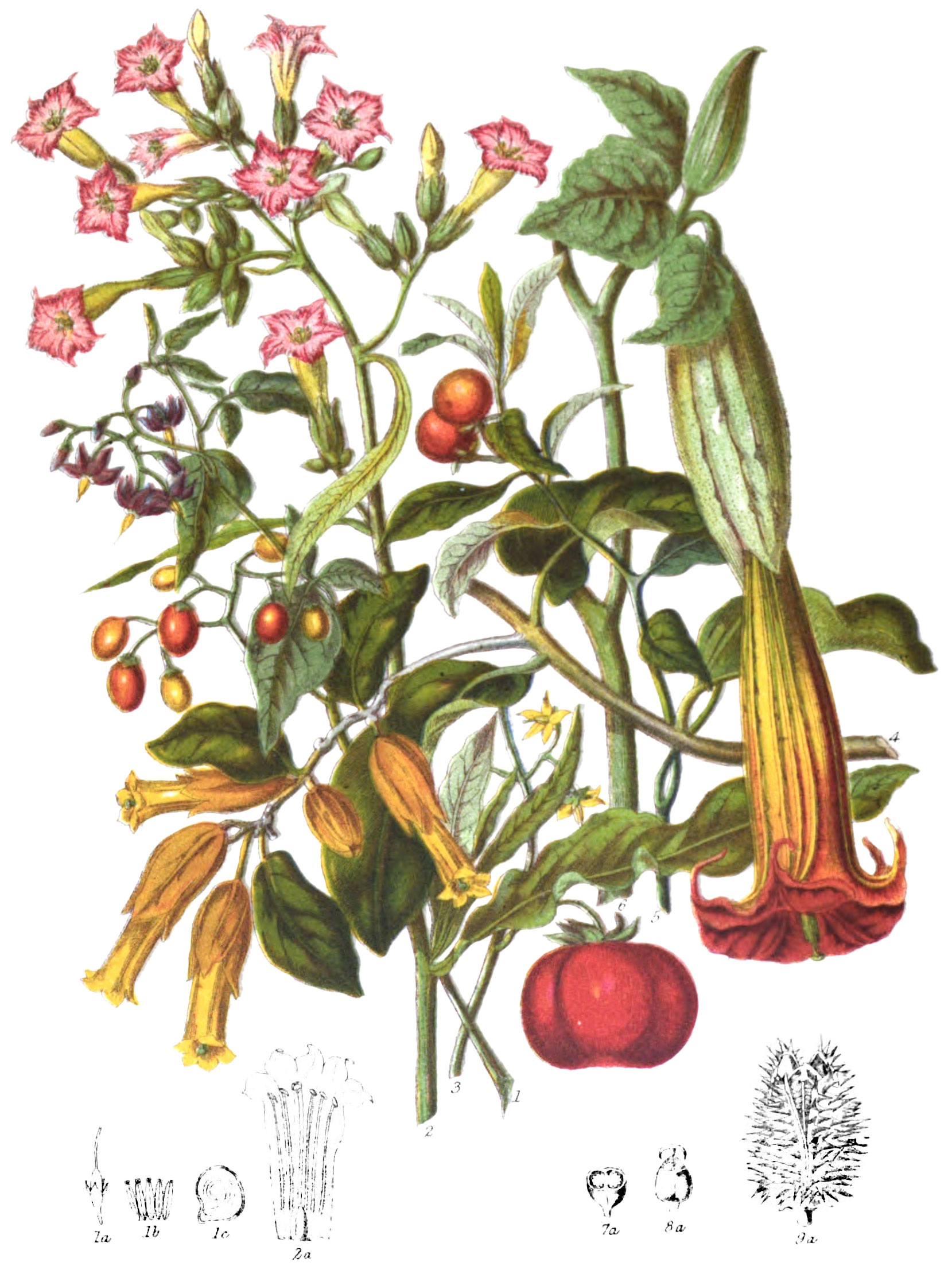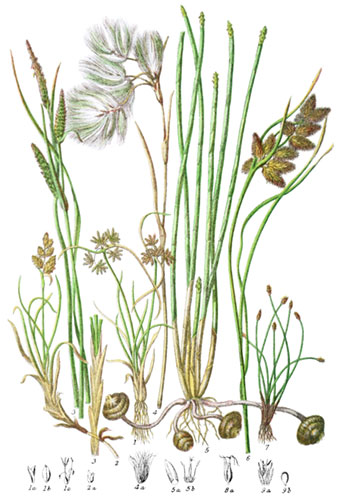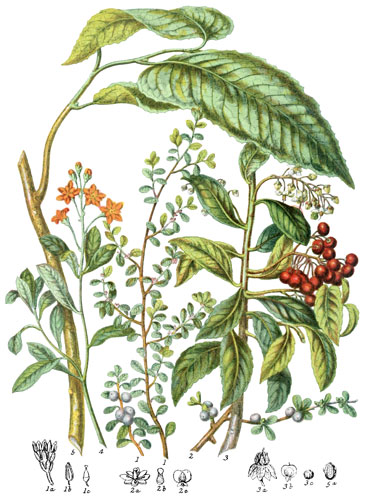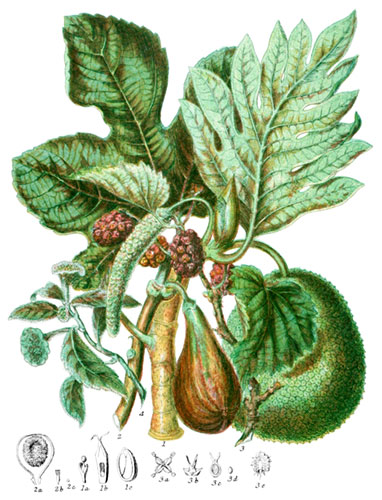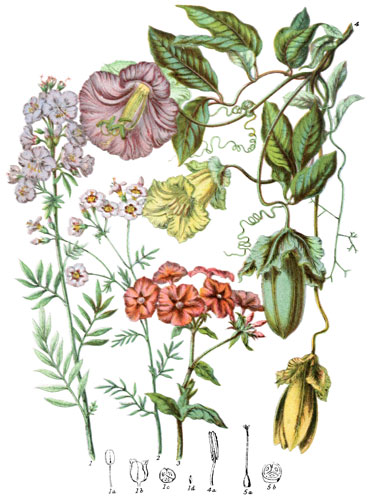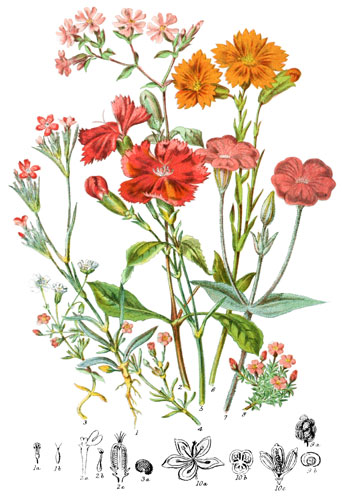Key characteristics
Trees, shrubs, and herbaceous plants. The leaves are alternate, undivided, or lobed; some near the flowers are placed close together. The flowers are various, sometimes growing from the base of the leaf-stalk. The calyx is below the ovary, five-parted, seldom four, persistent. The corolla is of one petal, attached below the base of the ovary; the top five-cleft, seldom four, regular. The stamens are inserted upon the corolla, as many as its segments, and alternate with them; the anthers burst by pores, or lengthwise. The ovary is usually two-celled; the style single, stigma simple. The seed-vessel is a capsule with two, four, five, or many cells; or a berry; the seeds are many, and contain fleshy albumen.
This Tribe is chiefly distinguished from Scrophulariaceæ by the flowers being regular, as with many stamens and lobes.
Narcotic and even poisonous properties exist in these plants, as well as wholesome food in some portions.
Select plants in this order
Not all plants listed are illustrated and not all plants illustrated are listed.
- Solanum includes herbaceous weeds, some of which are noxious, spiny shrubs, and a very few trees; the nutritious potato, the narcotic tobacco, and several medicinal species of value.
- S. dulcamara (1) is common throughout Europe; it is sometimes called Bittersweet, the roots having first a bitter, then a sweet flavour.
- S. nigrum the other British species, with white flowers and black berries, is narcotic; this is one of the three English plants found in the Galapagos Isles.
- The fruit of S. Lycospersicum (3) is more esteemed for food on the Continent than here, and is much cultivated in the south of Italy.
- S. melongena, the egg-plant, is grown both in the East and West Indies for the sake of the fruit, in shape and whiteness like an egg. In the north of Africa it is plentiful, and is eaten at Tangier by Moors and Europeans.
- S. ethiopicum supplies Chinese Mandarins with a delicate fruit the size of cherries.
- But the most important beyond compare is S. tuberosum, the Potato, first brought to Spain from the Andes, near Quito, early in the sixteenth century; it was thence taken to Italy and Vienna. Sir Walter Raleigh found it in Virginia, and introduced it to England and Ireland in 1586. Towards the end of the eighteenth century it became spread all over Europe, except the hot parts of Spain, and was accepted as a wholesome and valuable addition to the common food of man. Potatoes are not true roots, but tubers formed on underground branches, and contain leaf-buds arranged spirally around, capable of producing new plants.
- On the plains of Brazil grows S. undulatum, eight feet high, with thorny branches, large purple flowers, and fruit nine inches in diameter.
- S. laciniatum yields the eatable Kangaroo apple in Tasmania.
- Nicotiana (2) is better known by its name of Tobacco; derived from the Mexican place of its growth; for nearly three hundred years it has been the favourite narcotic in almost every country in the world, rivalled chiefly by the Betel of the East. It was first used by Sir Walter Raleigh, who thus provided the English with two popular plants out of this tribe. Immense quantities are cultivated in America, China, Japan, and other European countries, as well as in Europe, wherever the temperature is sufficiently hot. The leaves being the part used, great care is taken to encourage their growth, rather than that of the flowers.
- N. rustica, with green flowers is also grown in Germany.
- Among the powerful narcotic medicines afforded by this tribe, Hyoscyamus niger Henbane is the most ancient in fame; it grows on heaps of rubbish in various countries, usually in the neighbourhood of dwellings. The corolla is delicately veined; The capsule (8)* opens with a lid, and contains numerous seeds.
- Datura stramonium, the Thorn Apple (9)† of South America, is now indiginous here; the whole plant is poisonous, but some parts yield medicine.
- Atropa Belladonna affords a powerful medicine for the eyes; the black berries are poisonous.
- The Hottentots obtain a virulent poison for their arrows from Acocanthera venenata.
- Juanulloa (4), named after two scientific botanists of Madrid, is an exception to the usual character of these plants, being parasitic in growth.
- The seeds of Capsicum baccatum (5) when pounded are known as Cayenne Pepper. The pods are used in the West Indies as a pungent seasoning for food.
- Those of C. annum are generally pickled in a green state.
- Brugmansia sanguinea (6) is one of the ornamental shrubs of Peru; the flowers of all the species are graceful in form; those of B. arborea are large and exceedingly fragrant.
- Physalis alkekengi, with its scarlet berry enclosed in the inflated membranous calyx, is thought pretty in our gardens; in Switzerland the fruit is commonly eaten.
- Verbascum is a genus of considerable beauty, native in Britain and throughout Europe; the leaves and stem are in some species so abundantly clothed with downy cotton that it is used for the wicks of lamps.
- Petunia, Nierembergia and Salpiglossis are all South American, now contributing countless varieties of gay flowers, hardy enough to flourish in European gardens.
Locations
This Tribe is found in nearly all countries except those within the Arctic and Antarctic Circles, most abundant in the Tropics, and chiefly in species of Solanum.
Legend
- Solanum dulcamara, Nightshade. England.
- Calyx and Pistil.
- Stamens.
- Stamen.
- Section of Seed.‡
- Nicotiana tabacum, Tobacco. N. America.
- Flower, opened.
- Solanum Lycopersicum, Tomato. S. America.
- Juanulloa parasitica, Parasitic Juanulloa. Peru.
- Capsicum baccatum. East and West Indies.
- Brugmansia sanguinea, Red Brugmansia. Peru.
-
- Ovary of Petunia.
-
- Capsule of Hyoscyamus.
-
- Fruit of Datura Stramonium.
- *8 was mentioned in the original description but only 4a was illustrated.
- &dagger9 was mentioned in the original description but only 9a was illustrated.
- ‡1d was not in the original illustration.
Explore more
Posters
Decorate your walls with colorful detailed posters based on Elizabeth Twining’s beautiful two-volume set from 1868.
Puzzles
Challenge yourself or someone else to assemble a puzzle of all 160 botanical illustrations.
